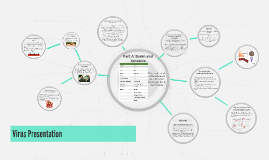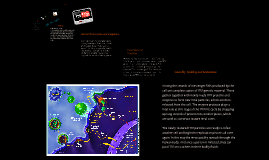Virus Presentation
Transcript: Human immunodeficiency virus (HIV) Virus Itself Is a genus of slow viruses of the Retroviridae family, characterized by a long incubation period. - Lentivirus (a member of the retrovirus family) . - Causes acquired immunodeficiency syndrome (AIDS), a condition in humans in which progressive failure of the immune system allows life-threatening opportunistic infections and cancers to thrive. Infection with HIV occurs by the transfer of blood, semen, vaginal fluid, pre-ejaculate, or breast milk. Within these bodily fluids, HIV is present as both free virus particles and virus within infected immune cells. The four major routes of transmission are unsafe sex, contaminated needles, breast milk, and transmission from an infected mother to her baby at birth (perinatal transmission). Screening of blood products for HIV has largely eliminated transmission through blood transfusions or infected blood products in the developed world. Group:Group VI (ssRNA-RT) Family:Retroviridae Genus:Lentivirus A retrovirus is an RNA virus that is duplicated in a host cell using the reverse transcriptase enzyme to produce DNA from its RNA genome. Structure What does HIV look like? Outside of a human cell, HIV exists as roughly spherical particles (sometimes called virions). The surface of each particle is studded with lots of little spikes. An HIV particle is around 100-150 billionths of a metre in diameter. HIV particles are much too small to be seen through an ordinary microscope. However they can be seen clearly with an electron microscope. HIV particles surround themselves with a coat of fatty material known as the viral envelope (or membrane). Projecting from this are around 72 little spikes, which are formed from the proteins gp120 and gp41. Just below the viral envelope is a layer called the matrix, which is made from the protein p17. The proteins gp120 and gp41 together make up the spikes that project from HIV particles, while p17 forms the matrix and p24 forms the core. The viral core (or capsid) is usually bullet-shaped and is made from the protein p24. Inside the core are three enzymes required for HIV replication called reverse transcriptase, integrase and protease. Also held within the core is HIV's genetic material, which consists of two identical strands of RNA. What is RNA? Almost all organisms, including most viruses, store their genetic material on long strands of DNA. Retroviruses are the exception because their genes are composed of RNA (Ribonucleic Acid). RNA has a very similar structure to DNA. However, small differences between the two molecules mean that HIV's replication process is a bit more complicated than that of most other viruses. How many genes does HIV have? Nine genes (compared to more than 500 genes in a bacterium, and around 20,000-25,000 in a human). Three of the HIV genes, called gag, pol and env, contain information needed to make structural proteins for new virus particles. The other six genes, known as tat, rev, nef, vif, vpr and vpu, code for proteins that control the ability of HIV to infect a cell, produce new copies of virus, or cause disease. At either end of each strand of RNA is a sequence called the long terminal repeat, which helps to control HIV replication. HIV life cycle Entry Replicate in human cells. A virus particle bumps into a cell that carries on its surface a special protein called CD4. The spikes on the surface of the virus particle stick to the CD4 and allow the viral envelope to fuse with the cell membrane. The contents of the HIV particle are then released into the cell, leaving the envelope behind. Reverse Transcription and Integration Once inside the cell, the HIV enzyme reverse transcriptase converts the viral RNA into DNA, which is compatible with human genetic material. This DNA is transported to the cell's nucleus, where it is spliced into the human DNA by the HIV enzyme integrase. Once integrated, the HIV DNA is known as provirus. Transcription and Translation HIV provirus may lie dormant within a cell for a long time. But when the cell becomes activated, it treats HIV genes in much the same way as human genes. First it converts them into messenger RNA (using human enzymes). Then the messenger RNA is transported outside the nucleus, and is used as a blueprint for producing new HIV proteins and enzymes. Assembly, Budding and Maturation Among the strands of messenger RNA produced by the cell are complete copies of HIV genetic material. These gather together with newly made HIV proteins and enzymes to form new viral particles, which are then released from the cell. The enzyme protease plays a vital role at this stage of the HIV life cycle by chopping up long strands of protein into smaller pieces, which are used to construct mature viral cores. The newly matured HIV particles are ready to infect another cell and begin the replication process all over again. In this way the virus quickly spreads through the human body. And once a person is infected, they can pass HIV

















